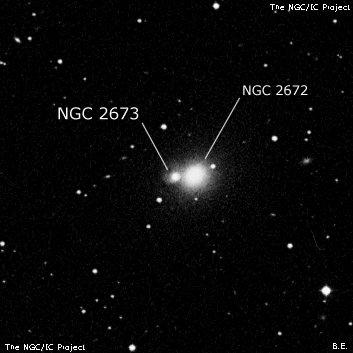
George Johnstone Stoney, Lord Rosse's assistant, discovered NGC 2673 (eastern component of the double system with NGC 2672) on 19 Dec 1849. He noted a "close double nebula, small star preceding." On 9 Feb 1855, R.J. Mitchell gave a more detailed description but incorrectly assumed NGC 2673 was h527 = NGC 2677: "very close, almost touching; h526 NGC 2672] is mbM, h527 is smaller and lbM." Dreyer later added the note "the latter is not h527, but the close companion to [NGC 2673], viz [GC] 1705." Interestingly, it's possible that both Herschels noted NGC 2673 in their observations, but thought it was a very faint star.
300/350mm - 13.1" (1/18/85): very faint, appears as an extremely small "knot" 20" diameter in the halo of NGC 2672 just 0.6' E of the core. Two stars are near NNE and SE.
400/500mm - 17.5" (1/28/89): very faint, extremely small, round. NGC 2673 appears as a small "knot" attached at the east end of NGC 2672 40" between centers. A mag 14 star is 1.0' SE and a mag 13.5 star lies 1.0' NNE.
600/800mm - 24" (2/16/15): at 322x; fairly faint, small, round, ~18" diameter. Easily visible glow just 35" E of the center of NGC 2672 and embedded in its low surface brightness halo. At 450x, the tiny nucleus occasionally brightens to a stellar point. A mag 14 star is just 50" SE. The pair is generally considered an interacting pair, resulting in a faint plume (not seen) extending to the southeast of NGC 2673.
Notes by Steve Gottlieb